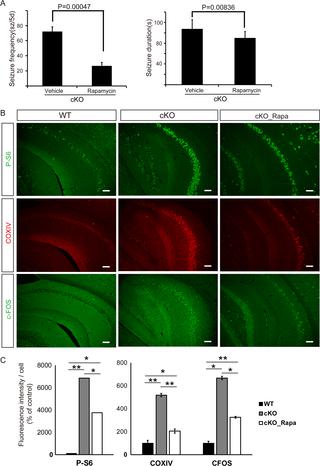Our official English website, www.x-mol.net, welcomes your feedback! (Note: you will need to create a separate account there.)
Epilepsy in a melanocyte-lineage mTOR hyperactivation mouse model: A novel epilepsy model.
PLOS ONE ( IF 3.7 ) Pub Date : 2020-01-24 , DOI: 10.1371/journal.pone.0228204 Fei Yang 1 , Lingli Yang 1 , Mari Wataya-Kaneda 1 , Lanting Teng 1 , Ichiro Katayama 1
PLOS ONE ( IF 3.7 ) Pub Date : 2020-01-24 , DOI: 10.1371/journal.pone.0228204 Fei Yang 1 , Lingli Yang 1 , Mari Wataya-Kaneda 1 , Lanting Teng 1 , Ichiro Katayama 1
Affiliation

|
OBJECTIVE
To clarify the complex mechanism underlying epileptogeneis, a novel animal model was generated.
METHODS
In our previous research, we have generated a melanocyte-lineage mTOR hyperactivation mouse model (Mitf-M-Cre Tsc2 KO mice; cKO mice) to investigate mTOR pathway in melanogenesis regulation, markedly reduced skin pigmentation was observed. Very unexpectedly, spontaneous recurrent epilepsy was also developed in this mouse model.
RESULTS
Compared with control littermates, no change was found in either brain size or brain mass in cKO mice. Hematoxylin staining revealed no obvious aberrant histologic features in the whole brains of cKO mice. Histoimmunofluorescence staining and electron microscopy examination revealed markedly increased mTOR signaling and hyperproliferation of mitochondria in cKO mice, especially in the hippocampus. Furthermore, rapamycin treatment reversed these abnormalities.
CONCLUSIONS
This study suggests that our melanocyte-lineage mTOR hyperactivation mouse is a novel animal model of epilepsy, which may promote the progress of both epilepsy and neurophysiology research.
中文翻译:

黑色素细胞谱系 mTOR 过度激活小鼠模型中的癫痫:一种新型癫痫模型。
目的 为了阐明癫痫发生的复杂机制,建立了一种新的动物模型。方法在我们前期的研究中,我们建立了黑素细胞谱系mTOR过度激活小鼠模型(Mitf-M-Cre Tsc2 KO小鼠;cKO小鼠)来研究mTOR通路在黑素生成调节中的作用,观察到皮肤色素沉着明显减少。非常出乎意料的是,在该小鼠模型中也出现了自发性癫痫复发。结果与对照同窝小鼠相比,cKO 小鼠的大脑大小或大脑质量没有变化。苏木精染色显示cKO小鼠的全脑没有明显的异常组织学特征。组织免疫荧光染色和电子显微镜检查显示,cKO 小鼠中 mTOR 信号传导显着增加,线粒体过度增殖,尤其是海马区。此外,雷帕霉素治疗逆转了这些异常。结论本研究表明,我们的黑素细胞系mTOR过度激活小鼠是一种新型的癫痫动物模型,可能会促进癫痫和神经生理学研究的进展。
更新日期:2020-01-26
中文翻译:

黑色素细胞谱系 mTOR 过度激活小鼠模型中的癫痫:一种新型癫痫模型。
目的 为了阐明癫痫发生的复杂机制,建立了一种新的动物模型。方法在我们前期的研究中,我们建立了黑素细胞谱系mTOR过度激活小鼠模型(Mitf-M-Cre Tsc2 KO小鼠;cKO小鼠)来研究mTOR通路在黑素生成调节中的作用,观察到皮肤色素沉着明显减少。非常出乎意料的是,在该小鼠模型中也出现了自发性癫痫复发。结果与对照同窝小鼠相比,cKO 小鼠的大脑大小或大脑质量没有变化。苏木精染色显示cKO小鼠的全脑没有明显的异常组织学特征。组织免疫荧光染色和电子显微镜检查显示,cKO 小鼠中 mTOR 信号传导显着增加,线粒体过度增殖,尤其是海马区。此外,雷帕霉素治疗逆转了这些异常。结论本研究表明,我们的黑素细胞系mTOR过度激活小鼠是一种新型的癫痫动物模型,可能会促进癫痫和神经生理学研究的进展。



























 京公网安备 11010802027423号
京公网安备 11010802027423号